Interior design of the kitchen-living room in Khrushchev

The combination of a kitchen and a living room does not cease to be the most demanded option for redevelopment in an apartment. And if we are talking about the Khrushchev with its small-sized rooms and the feeling of compressed space, it seems that there is simply no other option left. With a small kitchen with low ceilings, the apartment definitely loses something. Trying to combine two territories, the owner of such a dwelling gets the feeling of an expanded space. And this is even a psychologically competent move.


Pros and cons of combining
Before making radical changes in the apartment, check yourself again if you are ready to connect rooms. Obviously, the kitchen in "Khrushchev" is not the place where a large company can gather. Even household members rarely fit at the dinner table all at once. This disconnecting factor speaks in favor of a combined room. In the kitchen-living room, everything is in plain sight: while one is preparing dinner, the other household is relaxing, communicating, and maybe helping someone who is busy with culinary affairs.
It is difficult to do this in a small kitchen - it is difficult for one to turn around, the company only interferes.
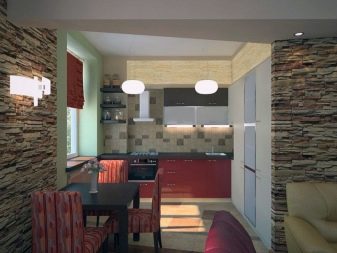

Finally, the space itself - the room becomes open and wide open to the eyes. It often seems that there is much more light in the room combined with the hall. The effect of novelty is also important - just repairing a small kitchen is not perceived as dramatically as the redevelopment of a space. Without moving, you are like settling into a new apartment.


The cons are also worth noting.
- Inability to retire... In such a kitchen you cannot shut yourself off from everyone, you cannot shut yourself off.Therefore, those housewives who are interested in cooking without witnesses should think seriously about the need to combine.
- When two rooms are combined, they turn into one space, which should be stylistically unified. And this means that repairs will have to be done in fact in two rooms, which increases its price.
- To prevent furniture and textiles from absorbing kitchen odors, you will have to acquire a powerful exhaust system.
And of course, the redevelopment must be documented: any redistribution of an apartment project that violates the law, at least threatens with fines.


Features of the layout
The load-bearing wall is not demolished - they simply will not be given permission: the risk of a collapse is very high. But the layout can be changed in several ways.
- Demolition of an entire wall... If the controlling organization has given the go-ahead, the wall between the kitchen and the hall is dismantled. The area can be increased due to the corridor adjacent to the room (but this is a rare case). The workplace falls into an alcove niche, the dining area is located between two windows, and the living room is where the hall was in the Khrushchev.


- The wall is where the doors were. This means that the doorway to the kitchen is blocked. The entrance to the kitchen implies a path through the living room, the working area becomes larger due to the additional meters of the wall.
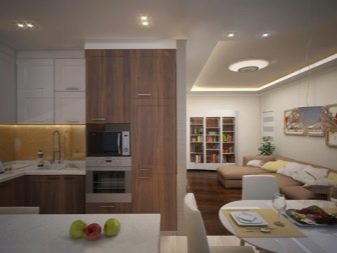

- Demolition of a fragment of the wall. The wall is demolished by half or 2/3. The working area is located along the perimeter of three walls, a partial wall is also taken into account. The dining room can also be positioned between the windows - this is the most popular option. A wide window sill can be replaced with a bar counter.


- Additional partition... The connecting wall is completely demolished, a partial partition is erected in the center, running parallel to the windows. This lengthens the working area.
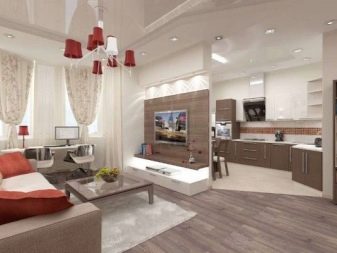

Each option is good in its own way. But most often only a fragment of the wall is demolished, this is in many cases a compromise option.
Space zoning
To correctly designate the space is an important element of the arrangement of the combined territory. There are several good design tricks that can help you create visual and functional zoning. Ceiling and lighting are a common option for dividing territories. Chandeliers and sconces in the living area and spotlights in the kitchen are very convenient. Spotlights are harmoniously positioned over the entire surface of the ceiling.
Each functional section can have its own local lighting. The shape of the ceiling also works as a divider when using complex structures.

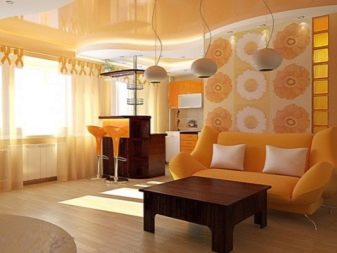
Other methods also help to zone a room in an apartment.
- The difference is in the finish. If you just play with colors and textures, the rooms will already visually differ. For example, in the kitchen, the floor is tiled, and in the living room, it is laminated. If the wall has been completely torn down, the difference in flooring can be made at a slight angle that does not follow the line of the former wall.


- Wallpaper color. They do not even have to be "partners", the main thing is that they do not "conflict" with each other. Since the combined area is still not very large, it is more profitable to use light shades, but bright accents are possible.
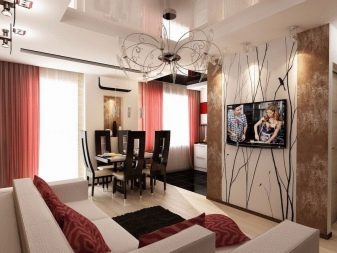

- Sofa. A classic example - the sofa is turned back to the kitchen and itself serves as a divider. Behind it there can be a small island or a rack of the same height.


- Canteen. Sometimes this third zone wedges into the section between the two main ones. This is good if there is no opening or arch (the space is open).
Curtains and decorative curtains made of beads can act as a zonator. But they are usually bright, textured, and can lead to the opposite effect (weighting the space).


Style solutions
Choose those democratic styles that do not set a large footage as the main requirement, because even a united room in a “Khrushchev” building will not look huge.
The most preferred today is the Scandinavian style and its variations. And, meanwhile, there are a lot of variations.There are examples when the style draws inspiration from the past, from the interior fashion of the 70s. Therefore, those who still have furniture of those times are desperately restoring it and returning it to the interior.
Together with modern finishes, decor, textiles and household appliances, it looks interesting and stylish.

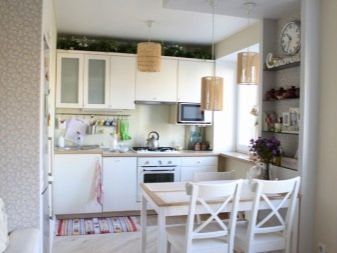
The Scandi version is good because it has a lot of light, a lot of naturalness and graceful simplicity. It doesn't cost a lot and is quite a compromise on inclusions from other styles (if they are not very intrusive). For a renovation limited in funds, for a small room, for a desire to bring fresh air and good daylight into a space, the Scandinavian style is ideal.


Minimalism will also be appropriate. This is the most laconic style that does not tolerate special embellishment, complex prints and color combinations. It is suitable for those who are tired of living in cramped conditions and things accumulating in it. Minimalism cuts off everything unnecessary, leaves only basic and irreplaceable items. It will not be annoying with bright finishes and decorative details.


You can also experiment with ethnic style. The main thing is not to flaunt it, not to compliment the direction on every meter of the room. Withstand colors, textures, decor very limited in presentation - and in the combined room sultry Moroccan notes or the beauty of the African continent may appear, and maybe the aesthetics of the heritage of your homeland.


Color spectrum
While the top tip is to use only light colors, consider whatever options you like. If you gravitate towards a variegated, darkish wallpaper, you should not immediately abandon them. But you need to understand that the expressive design of the walls requires a less expressive setting. But against the background of white wallpaper, you can equip anything - this neutral base "unties the hands" of the owners.


Fashionable colors today:
- spicy honey;

- sky blue;

- turquoise with ice;

- caramel summer;

- cocoa with milk.

If you decide to make the accent wall dark, then choose bright wallpaper with a very large (but rare) print. It looks solid, stylish. For example, the central wall is chocolate-colored with huge stylized flowers or abstract geometric patterns, the rest of the walls are a shade of coffee and cream, smooth and monochromatic. The interior will turn out to be warm and fashionable.

Finishing options
It all depends on financial capabilities, of course, but even democratic projects today look no less inspiring than renovations with high costs. Those who are familiar with the concept of "hygge" and have read books about the Danish phenomenon know that expensive renovations and deliberately rich furnishings are considered indecent in Scandinavia. This philosophy is slowly moving into Slavic interiors.
Therefore, it is quite fair that people began to abandon gilding and furniture with a claim to Art Nouveau or Renaissance in small rooms. NSyou will find simplicity and brevity, devotion to things that may no longer be ideal, but strong and beloved by all household members.
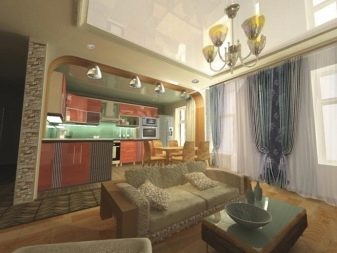

If you want the same democratic and popular renovation, remember:
- it is good if the wallpaper serves as a base, and not an independent part of the interior;
- flooring made from natural materials is always a priority;
- the ceiling can be simply painted - tension options do not comply with the principles of environmental friendliness;
- smooth walls in a small room are preferable to textured ones.
And if it seems that the finish is rustic, high-quality organization of lighting will help to divert attention from this.
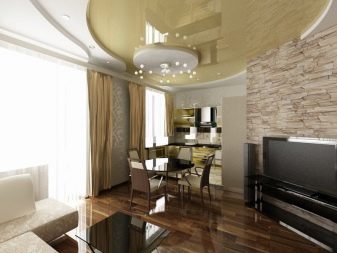



Organization of lighting
There is a chandelier in the center of the living room. Ideally, it should illuminate all areas at once. But due to the local illumination attached to the headset, there will be no problems in the dark, when the chandelier gives general light, and there is not enough local light.
In the living room, near the sofa, there may be a floor lamp or a table lamp on a curbstone, on a chest of drawers, on a shelf. Such simple solutions are in demand again.
And while the hostess is preparing or cleaning the kitchen, the rest of the household can watch TV under the dim light of a local lamp.


Selection of furniture and appliances
If you choose exactly low and compact furniture, due to its space, it can look like a dollhouse, not very solid. Of course, bulky and massive things should be avoided, but you should also not strive for the choice of mini-furniture.
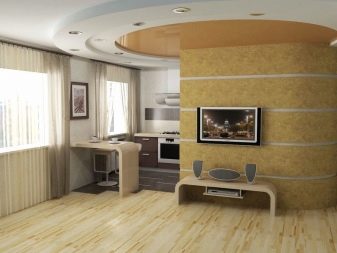
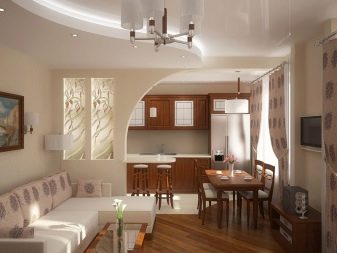
If it is possible to move the cabinets to other parts of the apartment, free up space from them. Think about what you can easily give up in favor of, for example, a roomy dining table. Perhaps the wall-slide will be superfluous, and not its shelves, but niches in the wall will become the library. Try to take the sofa lighter: it always looks solid indoors. Being very dark will slightly change the visual perception not for the better.


Textiles and decor elements
You need to be careful with decorative design. Try to make them not endless figurines and paintings, but more functional decor. For example, napkins, tablecloths, table runners are already strong decorative accents that do not require reinforcement. Cushions that play up the style of the room can be a good decor.
If there are vases in the room, then transparent ones that play with light will be the best choice.


You can do without a carpet, but why do it if it helps the space to become cozier and warmer. If your sofa has a low table, have a not-so-dark carpet underneath it. But the option in the whole living room will be superfluous. You can make several sets of chair covers at the table that will change the mood of the room.


Successful examples
And finally, a few successful and beautiful examples confirming that a stylish interior design can be in the "Khrushchev".
- A light space with a warm accent of burnt grass.
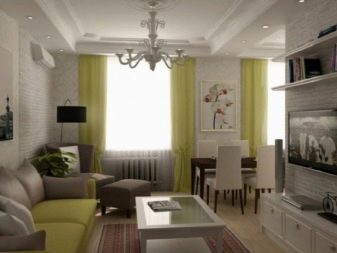

- A room with beautiful chocolate accents.

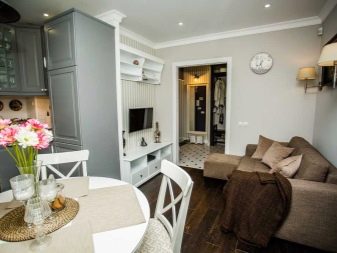
- Without a wall, but with high-quality zoning in the form of a difference in flooring.

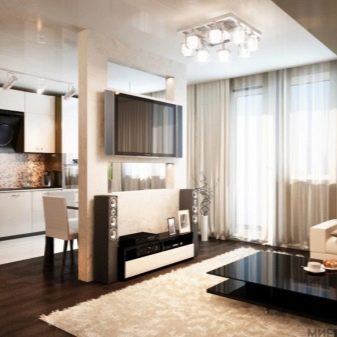
- The mood color is black ... or is it blue? The kitchen-living room is a real hit.
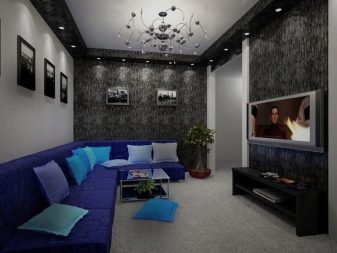

- Minimalism pleasing to the eye with a Scandinavian mood.
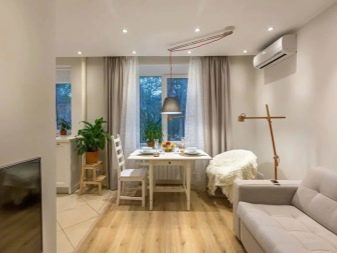

- Laminate on the wall - and it's really trendy.


- Modern, graphic and dynamic.


“Khrushchevka” cannot be compared with modern apartments, in which one kitchen allows, it seems, to play football. But this does not mean that a small area is not suitable for creating a stylish and very modern interior, especially if it decorates combined rooms.
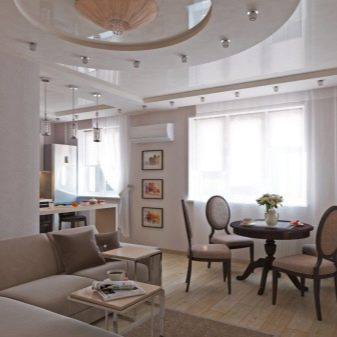

For information on how to arrange furniture in the kitchen-living room, see the next video.








